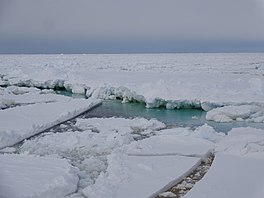Our website is made possible by displaying online advertisements to our visitors.
Please consider supporting us by disabling your ad blocker.
Ross Sea
| Ross Sea | |
|---|---|
 Sea ice in the Ross Sea | |
 Seas of Antarctica, with the Ross Sea in the bottom-left | |
| Location | Antarctica |
| Coordinates | 75°S 175°W / 75°S 175°W |
| Type | Sea |
| Etymology | James Ross |
| Primary outflows | Southern Ocean |
The Ross Sea is a deep bay of the Southern Ocean in Antarctica, between Victoria Land and Marie Byrd Land and within the Ross Embayment, and is the southernmost sea on Earth. It derives its name from the British explorer James Clark Ross who visited this area in 1841. To the west of the sea lies Ross Island and Victoria Land, to the east Roosevelt Island and Edward VII Peninsula in Marie Byrd Land, while the southernmost part is covered by the Ross Ice Shelf, and is about 200 miles (320 km) from the South Pole. Its boundaries and area have been defined by the New Zealand National Institute of Water and Atmospheric Research as having an area of 637,000 square kilometres (246,000 sq mi).[1]
The circulation of the Ross Sea is dominated by a wind-driven ocean gyre and the flow is strongly influenced by three submarine ridges that run from southwest to northeast.[citation needed] The circumpolar deep water current is a relatively warm, salty and nutrient-rich water mass that flows onto the continental shelf at certain locations.[2][3] The Ross Sea is covered with ice for most of the year.[citation needed]
The nutrient-laden water supports an abundance of plankton and this encourages a rich marine fauna. At least ten mammal species, six bird species and 95 fish species are found here, as well as many invertebrates, and the sea remains relatively unaffected by human activities. New Zealand has claimed that the sea comes under its jurisdiction as part of the Ross Dependency. Marine biologists consider the sea to have a high level of biological diversity and it is the site of much scientific research. It is also the focus of some environmentalist groups who have campaigned to have the area proclaimed as a world marine reserve. In 2016 an international agreement established the region as a marine park.[4]
- ^ "About the Ross Sea". NIWA. 27 July 2012. Archived from the original on 24 February 2018. Retrieved 23 February 2018.
- ^ Jacobs, Stanley S.; Amos, Anthony F.; Bruchhausen, Peter M. (1 December 1970). "Ross sea oceanography and antarctic bottom water formation". Deep Sea Research and Oceanographic Abstracts. 17 (6): 935–962. Bibcode:1970DSRA...17..935J. doi:10.1016/0011-7471(70)90046-X. ISSN 0011-7471.
- ^ Dinniman, Michael S.; Klinck, John M.; Smith, Walker O. (1 November 2003). "Cross-shelf exchange in a model of the Ross Sea circulation and biogeochemistry". Deep Sea Research Part II: Topical Studies in Oceanography. The US JGOFS Synthesis and Modeling Project: Phase II. 50 (22): 3103–3120. Bibcode:2003DSRII..50.3103D. doi:10.1016/j.dsr2.2003.07.011. ISSN 0967-0645.
- ^ Cite error: The named reference
Guardian Slezak 2016was invoked but never defined (see the help page).
Previous Page Next Page



